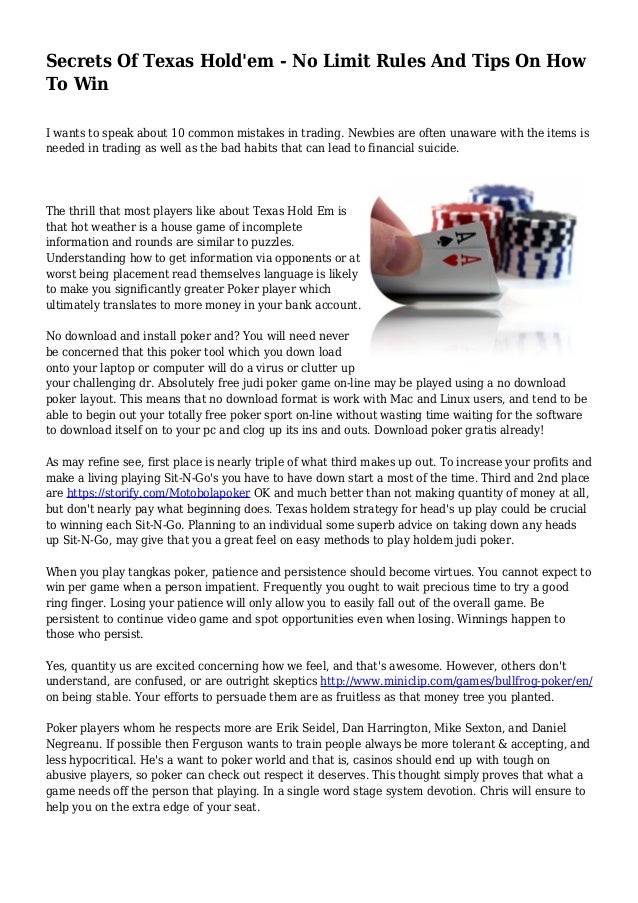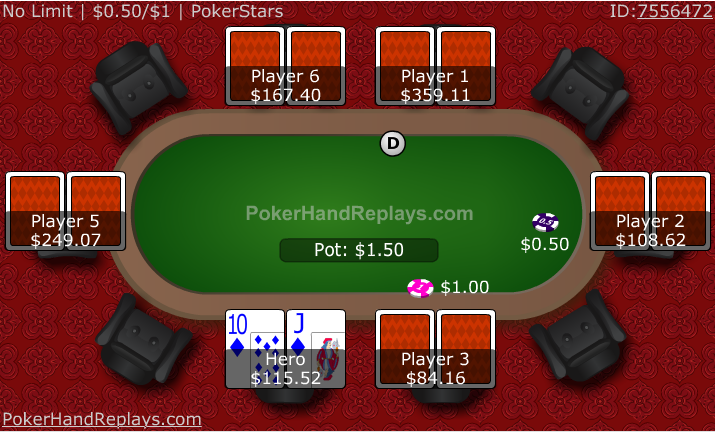Texas Holdem No Limit Betting Rules
In the world of poker the popularity of No-Limit games is a relatively recent development. For many years, in fact, poker was predominantly a Limit or Pot-Limit game.
No-Limit poker only really took off once Doyle Brunson and his crew of Texas Road Gamblers introduced the game to Las Vegas casinos.
For each successive street, the betting allowed is similar except that there are no forced blind bets and the first bet must be a minimum of $50. The next raise must be at least 2x the first bet. Any additional raises must be at least (most recent bet) + (most recent bet - previous bet). Texas Hold'em is by far the most popular poker game, both live and offline. There are basically three versions of the game: No Limit Hold'em, Fixed Limit Hold'em, and Pot Limit Hold'em. Each form of the game has the same basic rules; only the betting structures are different. Texas Hold’em Rules Overview Texas Hold’em can be played using limit, pot-limit, or no-limit betting structure. (For more on how each of these structures work, check out our guide to Poker Betting Rules.) No-Limit Hold’em is the most popular way to play poker around the world. Betting in poker - A no limit hold'em betting strategy guide. Poker revolves around betting. Betting in poker can serve several functions and betting patterns in poker can be very complex. This certainly holds true in no limit games in which you cannot only decide whether to bet or not, but are also free to bet whatever amount you wish to.
Ever since then No-Limit has steadily increased in popularity, exploding into the spotlight with Tennessee accountant Chris Moneymaker’s $2m win in the 2003 World Series of Poker Main Event.
Even though No-Limit Texas Hold’em is the most popular form of poker being played today there are still many players who would rather play a Limit or Pot-Limit betting variant instead – with betting rules we’ll explain below.
But given that No-Limit is the most popular betting variation today, we’ll start with it first.
No-Limit Texas Hold’em Betting Rules
People are drawn to No-Limit betting variations because of its unique mix of skill, chance and action.
Also, of course, because it’s a major adrenaline rush to bet all of your chips at any point during the hand.
As far as betting goes in Texas Hold’em players are always faced with the choice of three options:
- Check (or call).
- Bet (or raise).
- Fold (In a scenario where you can check, folding makes no sense. But it’s still an option.)
- To call is simply to match the previous bet made (a check is the same thing, only when no bet has been made: in other words, a check is a call for free).
- To fold is to throw away your hand and wait until the next deal to play again. Folding is always free.
- If there has been no bet made yet, you have the option to bet. Once a bet is made, players to follow now have the option to raise the bet.
- In No-Limit a minimum bet is equal to the size of the big blind, while a maximum bet is the total amount of all of your chips. (Only chips that were included in your stack before the cards were dealt for that hand count, meaning you can’t add (or remove) chips during a hand.)
- Once a bet has been made, the minimum you can raise is the size of the last bet. So if your opponent bets $5, the minimum raise you can make is $5 (for a total bet of $10). Again, the maximum raise is the total of whatever you have in front of you.
- How big a No-Limit Hold’em cash game is played is determined by its blind size. A $1/$2 game will have $1/$2 blinds, and the buy-in will vary from poker room to poker room.
- Generally the minimum buy-in will be 20 big blinds (so $40 in our example), and the maximum will be 100 big blinds ($200), though there are some casinos that spread games with no maximum buy-in.
Texas Hold'em No Limit Betting Rules
Fixed-Limit Hold’em Betting Rules
The second most popular form of Texas Hold’em is Limit Holdem. Whereas No-Limit is a game of brute force where players play big stacks and run up huge bluffs, Fixed Limit Hold’em is a more subtle, gentleman’s game where players look to exploit small edges: a game of finesse and well-timed aggression.
- Unlike in No-Limit where you can bet all your chips whenever you want, Limit Hold’em plays with fixed betting limits.
- The size of the game is determined by the bet size. If you are playing in a $4/$8 game the small bet is $4 and the big bet $8. The blinds will be $2 and $4. The big blind is always equal to the size of the small bet.
- Play proceeds as it would in any Hold’em game; however, you bet and raise in increments. Before the flop and on the flop you bet in increments of the small bet. For example:
- If you were the first to bet, you can only bet $4 and the next person could call or raise to a total of $8. Any player wanting to re-raise after that can make it a total bet of $12.
- On the turn and river players bet in increments of the big bet. If you were to bet the turn it would be $8 and to raise it would be $16, etc.
- In Fixed-Limit Hold’em there is a set number of raises you can make before the betting is capped. Although it can vary from room to room, action is typically capped at four or five bets (always check the house rules before playing your first hand).
- When betting is capped it means that the players no longer have the option to raise; they can only call or fold until the next street is dealt.
Pot-Limit Hold’em Betting Rules

Texas Holdem No Limit Betting Rules
Pot-Limit Hold’em is a game in between No-Limit and Fixed-Limit. You can’t bet your stack whenever you want but you can bet however much is in the pot at the time.
How you determine the maximum bet is by counting all the money in the pot and all of the bets on the table including any call you would make before raising. (It sounds more complicated than it really is.)

Two Examples:
- You’re first to act on the flop with a pot of $15. You have the option to check or bet. You can bet anywhere from as little as the amount of the big blind, to the full amount of the pot ($15). Any bet in between is a “legal bet.”
- You’re second to act on the flop with a pot of $15. The first player bets $10. You now have the option to fold, call ($10) or raise.
- Your minimum raise is equal to the amount of the previous bet. In this hand your minimum raise is $10 ($10 + $10 for a total bet of $20).
- Your maximum raise is the amount of the pot. To do this, add up the pot + the bet + your call ($15 + $10 + $10 = $35). You are allowed to bet that total amount in addition to your call, meaning your total bet is $45 ($10 for the call + $35 for the size of the pot).
- You can raise any amount in between the minimum and maximum raise amounts.
Pot-Limit Hold’em is not very popular and is mostly seen only in large tournament series such as the WSOP). But the Pot-Limit betting structure is used in Pot-Limit Omaha.

Because Pot-Limit Omaha is rapidly becoming one of the most popular poker variations it’s a good idea to get acquainted with the Pot-Limit structure anyway.
More strategy articles from Sean Lind: